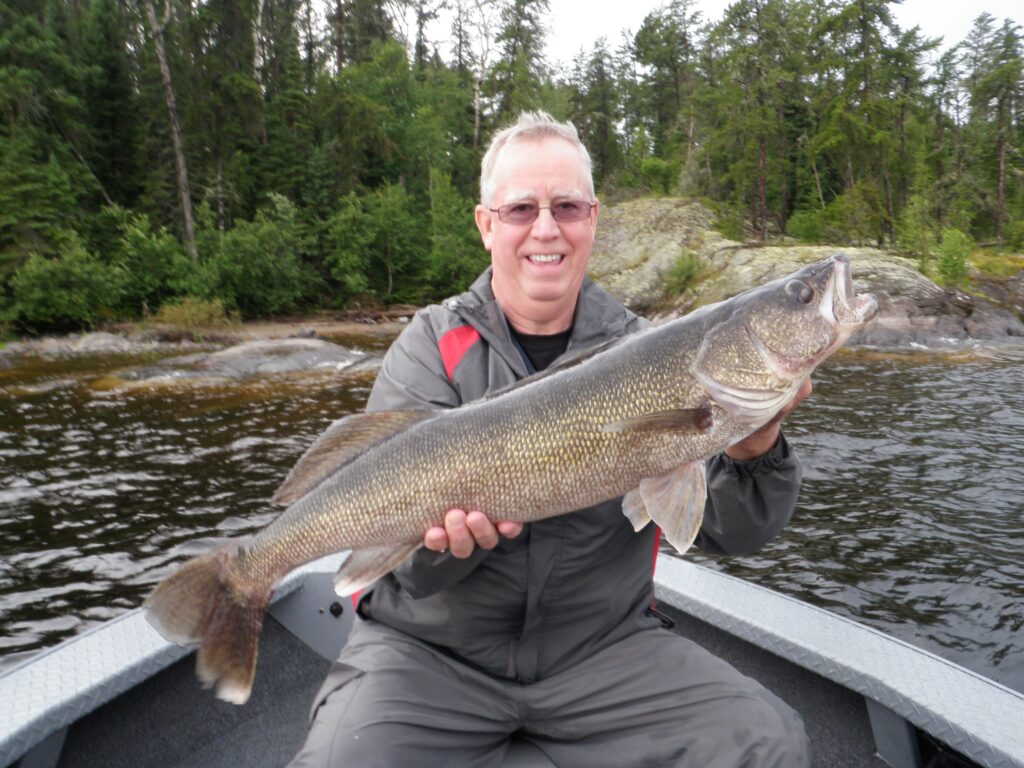We begin every morning by passing the weather sheet around the guide table. As it goes from hand to hand, you can almost see the wheels begin to turn. Every good guide knows that weather rules the walleye world. Each guide has his own guess as to what the day will hold, but we truly don’t know until we get on the water and the experiments begin. In different areas, in different orders, and at different speeds, we all apply the SWWL Formula. We let the fish tell us what is going to work by fishing fast, slow, deep, shallow, sand, rock, suspended, weeds, mega sand, and everything in between.
This week was a perfect example of why the Formula works. It began with variable weather and a large number of walleyes using main lake deep water rock structures (avg. 30 ft.). The weather shifted mid-week with torrential rains and storms followed by more stable conditions with heat and humidity. There were inches of rain this week. By the end of the week most of the active fish including big ones were being caught in much shallower water on main lake sand and even on transition sand in 12 – 20 ft. of water. The only way to win consistently was to be aggressively flexible and continuously searching.
Scanning and “Spot and Stalk” were critical components to this week’s success. If you pulled up to a spot and just started fishing live bait at .3 mph, then it would take you 30 minutes to learn what you could figure out in 3 minutes of scanning a structure with your electronics. We use Lowrance HDS products and they are awesome tools. In the end, a guide’s day boils down to math and efficiency. The more experiments you try, the more you scan, the faster you learn, and the more water you cover exponentially increases the odds of having a good to great day.
“Spot and Stalk” is a tactic that we have used more and more in the past few seasons. It requires open minded guests and discipline. There are many variations, but I usually have my guests reel up and I tell them to get ready. I drive the boat in reverse over structure quickly until I mark high quality hooks and then I pop the boat in to forward and say, “drop ‘em. Good arcs 3 ft. off the bottom in 25. Let your jigs hit bottom, make two turns on your reel and hold it steady!” Within 2 – 4 minutes we either get them or we don’t and then we move on. When it works, it feels great, but most of the time it is lose, lose, win, lose, ½ win, lose, win. It is hard work, but at the end of the day, you usually have a much better idea of what the walleyes are doing than the guys that are spot on spot sitters.
When the walleyes are spread out in all depth zones, our volume always suffers a bit. You just spend more time looking. Daily guide sheets averaged 35 – 40 walleyes over 18 in. per boat. The highest daily total was 80. For the week, we caught and released 50 walleyes over 27 in., including 11 – 28s, 3 – 29s, and 2 – 30s.
Big pike fishing kicked back into high gear again this week. Roughly 10% of our total effort was spent chasing pike, yet there were 12 over 37 in. caught this week, including 3 – 40s, 1 – 42, and 2 – 43’s. Top end Lac Seul pike aren’t just long, they are thick and this week’s big fish were giants. Spoons, in-line spinners, and glide baits were key producers in and around the weed beds close to deep water.
The Take Away:
There is a reason for the Formula – it works. Keep an open mind, search broadly, cover water, let the fish tell you what they are doing, and adjust. And tomorrow – do it again. There is no easy answer, so don’t look for one.

